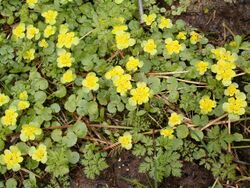Biology:Chrysosplenium
| Chrysosplenium | |
|---|---|

| |
| Chrysosplenium alternifolium | |
| Scientific classification | |
| Kingdom: | Plantae |
| Clade: | Tracheophytes |
| Clade: | Angiosperms |
| Clade: | Eudicots |
| Order: | Saxifragales |
| Family: | Saxifragaceae |
| Genus: | Chrysosplenium L.[1] |
| Species | |
|
See text | |
Chrysosplenium (golden saxifrage or golden-saxifrage) is a genus of 57[2] species of flowering plant in the family Saxifragaceae. Species can be found throughout the Arctic and northern temperate parts of the Northern Hemisphere, with the highest species diversity in eastern Asia; two species are found disjunctly in South America.[2]
They are soft herbaceous perennial plants growing to 20 centimeters tall, typically in wet, shady locations in forests. The leaves are rounded, palmately veined, with a lobed margin and arranged either alternately or opposite, depending on the species. The flowers are small, yellow or yellowish-green, with four petals; they are produced in small clusters at the apex of the shoots surrounded by leafy bracts. Most of the growth and flowering is in early spring, when more light is available under deciduous trees.
Selected species
- Chrysosplenium absconditicapsulum
- Chrysosplenium alpinum (alpine golden saxifrage)
- Chrysosplenium alternifolium (alternate-leaved golden saxifrage)
- Chrysosplenium americanum (American golden saxifrage)
- Chrysosplenium axillare
- Chrysosplenium biondianum
- Chrysosplenium carnosum
- Chrysosplenium cavaleriei
- Chrysosplenium chinense
- Chrysosplenium davidianum
- Chrysosplenium delavayi
- Chrysosplenium dubium
- Chrysosplenium flagelliferum
- Chrysosplenium forrestii
- Chrysosplenium fuscopuncticulosum
- Chrysosplenium giraldianum
- Chrysosplenium glechomifolium (Pacific golden saxifrage)
- Chrysosplenium glossophyllum
- Chrysosplenium griffithii
- Chrysosplenium hebetatum
- Chrysosplenium hydrocotylifolium
- Chrysosplenium iowense (Iowa golden saxifrage)
- Chrysosplenium japonicum
- Chrysosplenium jienningense
- Chrysosplenium lanuginosum
- Chrysosplenium lectus-cochleae
- Chrysosplenium lixianense
- Chrysosplenium macranthum
- Chrysosplenium macrophyllum
- Chrysosplenium microspermum
- Chrysosplenium nepalense
- Chrysosplenium nudicaule
- Chrysosplenium oppositifolium (opposite-leaved golden saxifrage)
- Chrysosplenium oxygraphoides
- Chrysosplenium pilosum
- Chrysosplenium pseudopilosum
- Chrysosplenium qinlingense
- Chrysosplenium ramosum
- Chrysosplenium serreanum
- Chrysosplenium sikangense
- Chrysosplenium sinicum
- Chrysosplenium taibaishanense
- Chrysosplenium tenellum
- Chrysosplenium tosaense
- Chrysosplenium trichospermum
- Chrysosplenium tetrandrum (northern golden saxifrage)
- Chrysosplenium uniflorum
- Chrysosplenium valdivicum
- Chrysosplenium wrightii (Wright's golden saxifrage)
- Chrysosplenium wuwenchenii
Culinary uses
The leaves and stems of golden saxifrage (C. alternifolium and C. oppositifolium) can be eaten in salads or as cooked greens.[3]
References
- ↑ Chrysosplenium. Flora of North America.
- ↑ 2.0 2.1 Soltis, D.E. (2001). Phylogenetic relationships and evolution in Chrysosplenium (Saxifragaceae) based on matK sequence data . Am J Bot 88:883-893
- ↑ Crawford, Martin. How to grow Perennial Vegetables. Green Books, 2012, p. 114
External links
Wikidata ☰ Q157593 entry
 |





